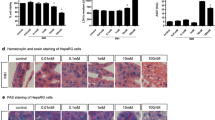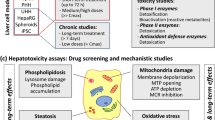Abstract
Rifampicin-induced hepatotoxicity has been well recognized in animals and patients. However, it is undetectable in cultured hepatocyte monolayers in vitro at the equivalent toxic concentration in vivo. This study investigated the rifampicin-induced toxicity on rat hepatocytes in gel entrapment vs. in monolayer culture. Thiazolyl tetrazolium reduction and albumin secretion were routinely detected to identify the toxic responses of rat hepatocytes to rifampicin, while reactive oxygen species (ROS) accumulation and intracellular glutathione (GSH) content were assayed as biomarkers of oxidative stress. In addition, Nile red staining and malondialdehyde (MDA) generation were, respectively, used as endpoints for lipid accumulation and peroxidation. After treatment of hepatocytes for 96 h at a serum rifampicin concentration (12 μM), gel-entrapped rat hepatocytes showed significant cellular damage indicated by alternations of all parameters indicated above, while hepatocyte monolayers did not show severe responses. In contrast to a lack of protections by cytochrome P 450 inhibitors, the ROS scavenger (glycyrrhizic acid) and thiol compounds (N-acetylcysteine and GSH) significantly reduced rifampicin toxicity in gel-entrapped hepatocytes. It appears that gel-entrapped rat hepatocytes reflected significant hepatotoxicity of rifampicin in vivo, and this toxicity was most possibly associated with oxidative stress and lipid accumulation.





Similar content being viewed by others
Abbreviations
- CYP:
-
cytochrome P
- DDC:
-
diethyl-dithiocarbamate
- DMSO:
-
dimethyl sulfoxide
- DTNB:
-
5,5-dithiobis(2-nitrobenzoic acid)
- GSH:
-
glutathione
- MDA:
-
malondialdehyde
- MTT:
-
methyl thiazolyl tetrazolium
- PBS:
-
phosphate buffer solution
- RFU:
-
relative fluorescence units
- ROS:
-
reactive oxygen species
- TBA:
-
thiobarbituric acid
References
Acocella G. Clinical pharmacokinetics of rifampicin. Clin Pharmacokinet 1978;3:108–27.
Adachi Y, Nanno T, Yamashita M, Ueshima S, Yamamoto T. Induction of rat liver bilirubin-conjugating enzymes and glutathione S-transferase by rifampicin. Gastroenterol Jpn 1985;20:104–10.
Advenier C, Gobert C, Houin G, Bidet D, Richelet S, Tillement JP. Pharmacokinetic studies of rifampicin in the elderly. Ther Drug Monit 1983;5:61–5.
Austerhoff A, Kindler U, Knop P, Knieriem HJ. Liver toxicity of combined rifampicin–isoniazid–ethambutol medication [author’s translation]. Dtsch Med Wochenschr (1946) 1974;99:1182.
Bajt ML, Knight TR, Lemasters JJ, Jaeschke H. Acetaminophen-induced oxidant stress and cell injury in cultured mouse hepatocytes: protection by N-acetyl cysteine. Toxicol Sci 2004;80:343–9.
Brøsen K, Skjelbo E, Rasmussen BB. Fluvoxamine is a potent inhibitor of cytochrome P4501A2. Biochem Pharmacol 1993;45:1211–4.
Brandon EF, Raap CD, Meijerman I, Beijnen JH, Schellens JH. An update on in vitro test methods in human hepatic drug biotransformation research: pros and cons. Toxicol Appl Pharmacol 2003;189:233–46.
De Rosa HJ, Baldan HM, Brunetti IL, Ximenes VF, Machado RG. The Effect of pyrazinamide and rifampicin on isoniazid metabolism in rats. Biopharm Drug Dispos 2007;28:291–6.
Donato MT, Lahoz A, Jimenez N, Perez G, Serralta A, Mir J, et al. Potential impact of steatosis on cytochrome P450 enzymes of human hepatocytes isolated from fatty liver grafts. Drug Metab Dispos 2006;34:1556–62.
Granville DJ, Tashakkor B, Takeuchi C, Gustafsson AB, Huang C, Sayen MR, et al. Reduction of ischemia and reperfusion-induced myocardial damage by cytochrome P450 inhibitors. Proc Natl Acad Sci USA 2004;101:1321–6.
Gumpricht E, Dahl R, Devereaux MW, Sokol RJ. Licorice compounds glycyrrhizin and 18beta-glycyrrhetinic acid are potent modulators of bile acid-induced cytotoxicity in rat hepatocytes. J Biol Chem 2005;280:10556–63.
Hermes-Lima M, Zenteno-Savin T. Animal response to drastic changes in oxygen availability and physiological oxidative stress. Comp Biochem Physiol C Toxicol Pharmacol 2002;133:537–56.
Hosagrahara VP, Hansen LK, Beilman GJ, Remmel RP. Evaluation of the effect of culture matrices on induction of CYP3A isoforms in cultured porcine hepatocytes. Chem Biol Interact 2000;127:91–106.
Kalra BS, Aggarwal S, Khurana N, Gupta U. Effect of cimetidine on hepatotoxicity induced by isoniazid–rifampicin combination in rabbits. Indian J Gastroenterol 2007;26:18–21.
Karthikeyan S. Isoniazid and rifampicin treatment on phospholipids and their subfractions in liver tissue of rabbits. Drug Chem Toxicol 2005;28:273–80.
Kern A, Bader A, Pichlmayr R, Sewing KF. Drug metabolism in hepatocyte sandwich cultures of rats and humans. Biochem Pharmacol 1997;54:761–72.
Kiso Y, Kato O, Hikino H. Assay methods for antihepatotoxic activity using peroxide-induced cytotoxicity in primary cultured hepatocytes. Planta Med 1985;51:50–2.
Kostrubsky VE, Ramachandran V, Venkataramanan R, Dorko K, Esplen JE, Zhang S, et al. The use of human hepatocyte cultures to study the induction of cytochrome P-450. Drug Metab Dispos 1999;27:887–94.
Li AP, Reith MK, Rasmussen A, Gorski JC, Hall SD, Xu L, et al. Primary human hepatocytes as a tool for the evaluation of structure–activity relationship in cytochrome P450 induction potential of xenobiotics: evaluation of rifampin, rifapentine and rifabutin. Chem Biol Interact 1997;107:17–30.
Li AP, Lu C, Brent JA, Pham C, Fackett A, Ruegg CE, et al. Cryopreserved human hepatocytes: characterization of drug-metabolizing enzyme activities and applications in higher throughput screening assays for hepatotoxicity, metabolic stability, and drug–drug interaction potential. Chem Biol Interact 1999;121:17–35.
Lu C, Li AP. Species comparison in P450 induction: effects of dexamethasone, omeprazole, and rifampin on P450 isoforms 1A and 3A in primary cultured hepatocytes from man, Sprague–Dawley rat, minipig, and beagle dog. Chem Biol Interact 2001;134:271–81.
Moon A, Kim SH. Effect of Glycyrrhiza glabra roots and glycyrrhizin on the glucuronidation in rats. Planta Med 1997;63:115–9.
Nicoll-Griffith DA, Chauret N, Houle R, Day SH, D’Antoni M, Silva JM. Use of a benzyloxy-substituted lactone cyclooxygenase-2 inhibitor as a selective fluorescent probe for CYP3A activity in primary cultured rat and human hepatocytes. Drug Metab Dispos 2004;32:1509–15.
Nieusma JL, Claffey DJ, Ruth JA, Ross D. Stereochemical aspects of the conjugation of epoxide metabolites of butadiene with glutathione in rat liver cytosol and freshly isolated rat hepatocytes. Toxicol Sci 1998;43:102–9.
Qiu HX, Su GG, Tang X, Meng Q. Tissue-like cultures of rat hepatocytes in study of phase I and phase II drug metabolism. J Zhejiang Univ Med Sci 2006;35:541–6.
O’Reilly T, Kunz S, Sande E, Zak O, Sande MA, Tauber MG. Relationship between antibiotic concentration in bone and efficacy of treatment of staphylococcal osteomyelitis in rats: azithromycin compared with clindamycin and rifampin. Antimicrob Agents Chemother 1992;36:2693–7.
Park EJ, Cho HY, Lee YB. Effect of cimetidine and phenobarbital on metabolite kinetics of omeprazole in rats. Arch Pharm Res 2005;28:1196–202.
Pilheu JA, De Salvo MC, Barcat JA. Effect of isoniazid and rifampicin regimens on the liver of tuberculosis patients. Medicina 1979;39:298–304.
Piriou A, Warnet JM, Jacqueson A, Claude JR, Truhaut R. Fatty liver induced by high doses of rifampicin in the rat: possible relation with an inhibition of RNA polymerases in eukariotic cells. Arch Toxicol Suppl 1979;2:333–7.
Piriou A, Maissiat R, Jacqueson A, Warnet JM, Claude JR. Ultrastructural changes in the parenchymal liver cells of rats treated with high doses of rifampicin. Br J Exp Pathol 1987;68:201–7.
Pirmohamed M, Williams D, Madden S, Templeton E, Park BK. Metabolism and bioactivation of clozapine by human liver in vitro. J Pharmacol Exp Ther 1995;272:984–90.
Rana SV, Attri S, Vaiphei K, Pal R, Attri A, Singh K. Role of N-acetylcysteine in rifampicin-induced hepatic injury of young rats. World J Gastroenterol 2006;12:287–91.
Rushmore TH, Kong AN. Pharmacogenomics, regulation and signaling pathways of phase I and II drug metabolizing enzymes. Curr Drug Metab 2002;3:481–90.
Ruslami R, Nijland HM, Alisjahbana B, Parwati I, van Crevel R, Aarnoutse RE. Pharmacokinetics and tolerability of a higher rifampin dose versus the standard dose in pulmonary tuberculosis patients. Antimicrob Agents Chemother 2007;51:2546–51.
Shen C, Zhang H, Zhang G, Meng Q. Isoniazid-induced hepatotoxicity in rat hepatocytes of gel entrapment culture. Toxicol Lett 2006;167:66–74.
Sodhi CP, Rana S, Mehta S, Vaiphei K, Goel RC, Mehta SK. Study of oxidative-stress in rifampicin-induced hepatic injury in growing rats with and without protein-energy malnutrition. Hum Exp Toxicol 1997;16:315–21.
Sodhi CP, Rana SF, Attri S, Mehta S, Yaiphei K, Mehta SK. Oxidative-hepatic injury of isoniazid–rifampicin in young rats subjected to protein and energy malnutrition. Drug Chem Toxicol 1998;21:305–17.
Taranger J, Girbal JP, Giacchero G. Rifampicin and liver function (72 punctures biopsies). Rev Tuberc Pneumol (Paris) 1970;34:717–20.
Upadhyay G, Kumar A, Singh MP. Effect of silymarin on pyrogallol- and rifampicin-induced hepatotoxicity in mouse. Eur J Pharmacol 2007;565:190–201.
Wang HZ, Chang CH, Lin CP, Tsai MC. Using MTT viability assay to test the cytotoxicity of antibiotics and steroid to cultured porcine corneal endothelial cells. J Ocul Pharmacol Ther 1996;12:35–43.
Wong SH, Knight JA, Hopfer SM, Zaharia O, Leach CN Jr, Sunderman FW Jr. Lipoperoxides in plasma as measured by liquid-chromatographic separation of malondialdehyde–thiobarbituric acid adduct. Clin Chem 1987;33:214–20.
Wu DQ, Zhang GL, Shen C, Zhao Q, Li H, Meng Q. Evaluation of diffusion in gel entrapment cell culture within hollow fibers. World J Gastroenterol 2005;11:1599–604.
Yew WW, Leung CC. Antituberculosis drugs and hepatotoxicity. Respirology (Carlton South) 2006;11:699–707.
Zhang JG, Dehal SS, Ho T, Johnson J, Chandler C, Blanchard AP, et al. Human cytochrome p450 induction and inhibition potential of clevidipine and its primary metabolite h152/81. Drug Metab Dispos 2006;34:734–7.
Acknowledgments
This research was supported by grants (no. 20576119 and 30772614) from NSFC (National Natural Science Foundation of China) and the Ph.D. Programs Foundation of the Ministry of Education of China (s. 20060335083).
Author information
Authors and Affiliations
Corresponding author
Rights and permissions
About this article
Cite this article
Shen, C., Cheng, X., Li, D. et al. Investigation of rifampicin-induced hepatotoxicity in rat hepatocytes maintained in gel entrapment culture. Cell Biol Toxicol 25, 265–274 (2009). https://doi.org/10.1007/s10565-008-9076-8
Received:
Accepted:
Published:
Issue Date:
DOI: https://doi.org/10.1007/s10565-008-9076-8




